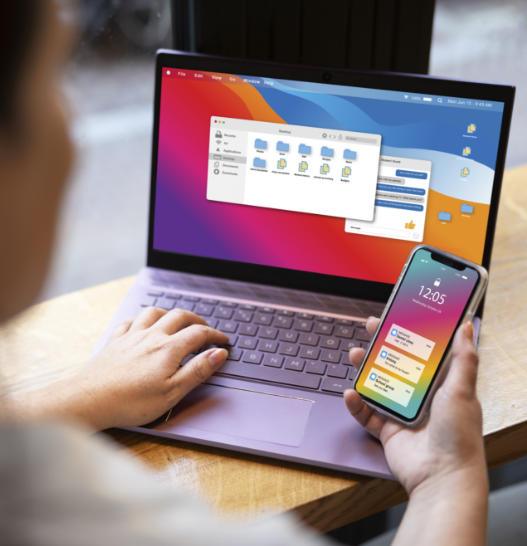What are usability and user experience?
The words “usability” and “user experience” have become buzzwords in the IT industry. Everybody uses them, but if you really ask, nobody really knows what they are. A study by the Stuttgart Media University (Laib et al. 2015), which asked companies in 2014 about their understanding of usability and user experience, came to the same conclusions. According to the study, almost all companies were familiar with the terms, but when asked, they could only provide a very vague definition. But how am I supposed to develop good products for my users if I don’t know what to measure “good” by? And that is BEFORE a product is on the market!
Usability describes the extent to which a product can be used efficiently, effectively and satisfactorily by a specific user for a specific purpose in a specific environment (DIN EN ISO 9241-11). Usability therefore means that it is easy and fast for the user to achieve his goals with the product. So much for the theory. In practice, this definition is often not very helpful. After all, you don’t just have one user and one task and one environment. In the application, you have many users, with many tasks and many different environments. So how do I recognize good usability?
Unfortunately, the answer is not that simple. In fact, there is no such thing as THE good usability. But there is always good usability for certain people. So if you want to achieve good usability of your products, you should gather as much information as possible about your potential users before you start developing. The usability of a product is higher, the better the product supports the main tasks of its users. Of course, this so-called task adequacy (DIN EN ISO 9241-110) is only one of many criteria mentioned in the DIN standard and other relevant books. And even naming a criterion does not mean that I know directly how to recognize a task-appropriate product. For this purpose, various methods such as usability tests and expert evaluations can be used to help me make task appropriateness visible.
And once I have measured and achieved task appropriateness as part of usability, there is still the question of user experience. User experience is also described in the German standard DIN EN ISO 9241-210. Here, User Experience is defined by the perceptions and reactions of a person that arise during the use or expected use of a product. User experience is much broader than usability and includes the user’s emotions, psychological and physiological reactions, expectations and behavior. User experience can thus be understood as a consequence that is influenced by the design, functionality, and performance characteristics of a product. In addition, prior knowledge and characteristics of the respective user, brand perception or the context of use can also play a role. It can therefore be seen that user experience is a very broad term, which is much more difficult to measure, even according to the definition, than it appears to be with usability. To determine user experience, methods such as surveys, eye movement measurements or the valence method are often used.
The variety of methods for measuring usability and user experience is large, and the effort required can vary greatly – depending on the product and method – and range from very little to huge. However, this article is not at all about how I can measure and achieve good usability and user experience, but about why I should try to do so in the first place.
Why are good usability and user experience important?
Good usability and user experience are more important than ever for successful products today. With the rapid proliferation of technology in our everyday lives, we have a situation for the first time in a long time where the vast majority of all technology users are not specifically trained in the use of technology. In the early days of computer use, computers were operated by specialists who had nothing in common with the typical user of today. Now, computers, cell phones, smartphones, tablets, smart TVs are so inexpensive and ubiquitous that everyone comes into contact with them and owns at least one of the devices themselves.
Due to the low level of prior knowledge of the users, the operation of most devices has also completely changed in the last 10 years and products, such as the first iPhone or the iPod, have contributed to the leap in the spread of technology due to their simplicity.
This development is great! Today, almost any user can get any information quickly and easily. People no longer search for information, they Google it. But this development has also changed user expectations. Tolerance for poor or complicated products has dropped significantly. This development is being fueled even more by the widespread use of apps. In most cases, apps only have a very limited range of functions and can only perform one or two tasks. But these are usually perfect! And if it turns out that an app is not easy to use or you don’t immediately understand what you have to do, then the app is uninstalled right away. Users today are no longer prepared for second chances.
And not only that: dissatisfied users also discourage other potential users from trying out a new product. Bad experiences in particular are often shared via social networks and packaged in reviews. However, a product with one or many bad reviews is seldom purchased by other clients.
On the other hand, good reviews or recommendations lead to products being purchased more frequently and users are more willing to try a new product. If it then turns out that the product is really good and simple, and in the best case even fun to use, then you have won a new client who – if things go really well – will also rave about the product to others. Satisfied clients are less likely to change products and have a higher level of product and brand loyalty. This reduces the cost of acquiring new customers and can save a company money.
But this is not the only way to reduce costs. Good usability leads to fewer support requests and bug fixes as well as product updates. This can also reduce many ongoing costs in the long term. In addition, it has been shown time and again that features and processes that are thought of directly during the development of a product can be integrated much more easily and cost-effectively than additional functions or changes to the existing product that are planted later.
And last but not least, good usability and user experience help to avoid losing out to the competition. Especially in the last few years, the trend towards usable and simple solutions has become more and more obvious in the B2B sector as well. Of course, this also has something to do with the changing user base of the products. Young users don’t understand why they can operate everything easily at home, but still have to work at work as they did 15 years ago. New solutions are needed here that manage to present even complex content in a simple way. Most users understand that in a B2B context it is often not possible to have a two-click solution. However, most users also understand that it should not be a 20-click solution.
This shows that usability and user experience should be companions and precursors of a successful product history and that today no development can be imagined without them. As long as you do not develop a product that offers users completely new possibilities, you will not get around a good design of your products. And that is good! After all, the only goal of your product is to be there for the user in the best possible way. We wish you every success.
Literature:
DIN EN ISO 9241 Part 11: Requirements for fitness for use – Guiding principles.
DIN EN ISO 9241 Part 110: Principles of dialog design.
Laib, M., Burmester, M., Ficano, C., Fronemann, N., Kolb, B., Krüger, A., Quesseleit, M.-L., Schippert, K. & Shinkarenko, M. (2015). User experience in software vendors.



